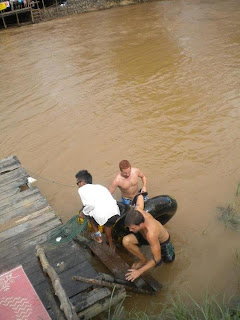Vang Vieng was poised to conquer the world as the best place of all to party. Except for one little problem, the lack of infrastructure. Imagine hundreds of backpackers going down a wild river (full of rocks), many of them drunk or mentally affected by different kinds of psicotropics, with no supervision or assistance whatsoever. Well, something has to go wrong, right? And it did, but the issue is that Vang Vieng, as probably any other city in Laos, has no decent medical facilities, which means that if you get seriously injured you have to drive (on bumpy one-lane roads) to the north of Thailand to find an acceptable hospital, a long and torturing trip.
The mentally ill, excessively drunk / drugged or just depressed, could die or get seriously injured by crashing into a rock, by playing on the "Death Slide" (a ceramic slide) or the rope swing, also nicknamed the "Death Swing". With so many death-somethings in Vang Vieng, it was no surprise to me when I recently read that the party was banned at the mythical city and it has now returned to its pre-2006 status. That change was certainly motivated by the more than 20 deaths in 2011 and 7 in 2012.
Too bad, what I saw in Vang Vieng, only 2 months before it was banned, was something unique and magical. There was a lot of freedom over there and I guess this is where the true problem lies. Some people just don't have enough responsibility to enjoy full play. Me and my friends had a blast, but we enjoyed within the safety limits that allowed us to leave the place in one piece, a minimum requirement for me to do anything. But the fact that they had to change a sign from "Don't jump" to "Don't jump or you will die", just proves that, unfortunately, some people were just not ready for Vang Vieng.
 |
| Picture: arriving at one of the many riverside bars |
 |
| Picture: the "Death Slide" |




